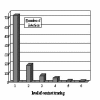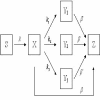Modeling secondary level of HIV contact tracing: its impact on HIV intervention in Cuba
- PMID: 20594313
- PMCID: PMC2909239
- DOI: 10.1186/1471-2334-10-194
Modeling secondary level of HIV contact tracing: its impact on HIV intervention in Cuba
Abstract
Background: Universal HIV testing/treatment program has currently been suggested and debated as a useful strategy for elimination of HIV epidemic in Africa, although not without practical issues regarding the costs and feasibility of a fully implemented program.
Methods: A mathematical model is proposed which considers two levels of detection of HIV-infectives through contact tracing of known infectives in addition to detections through other means such as random screening. Simulations based on Cuban contact tracing data were performed to ascertain the potential impact of the different levels of contact tracing.
Results: Simulation studies illustrate that: (1) contact tracing is an important intervention measure which, while less effective than random screening, is perhaps less costly and hence ideal for large-scale intervention programs in developing countries with less resources; (2) the secondary level of contact tracing could significantly change the basic disease transmission dynamics, depending on the parameter values; (3) the prevalence of the epidemic at the time of implementation of contact tracing program might be a crucial factor in determining whether the measure will be effective in preventing disease infections and its eventual eradication.
Conclusions: Our results indicate that contact tracing for detection of HIV infectives could be suitably used to remedy inadequacies in a universal HIV testing program when designing timely and effective intervention measures.
Figures





Similar articles
-
Modeling the impact of random screening and contact tracing in reducing the spread of HIV.Math Biosci. 2003 Jan;181(1):17-54. doi: 10.1016/s0025-5564(02)00128-1. Math Biosci. 2003. PMID: 12421551
-
HIV with contact tracing: a case study in approximate Bayesian computation.Biostatistics. 2010 Oct;11(4):644-60. doi: 10.1093/biostatistics/kxq022. Epub 2010 May 10. Biostatistics. 2010. PMID: 20457785
-
On the recent sharp increase in HIV detections in Cuba.AIDS. 2001 Feb 16;15(3):426-8. doi: 10.1097/00002030-200102160-00023. AIDS. 2001. PMID: 11273230 No abstract available.
-
Implementation of Universal HIV Testing and Treatment to Reduce HIV Incidence in Botswana: the Ya Tsie Study.Curr HIV/AIDS Rep. 2020 Oct;17(5):478-486. doi: 10.1007/s11904-020-00523-0. Curr HIV/AIDS Rep. 2020. PMID: 32797382 Review.
-
Partner notification program and possibility of including it in the HIV prevention strategies in Japan.J Epidemiol. 1996 Sep;6(3):158-65. doi: 10.2188/jea.6.158. J Epidemiol. 1996. PMID: 8952220 Review.
Cited by
-
Contact tracing - Old models and new challenges.Infect Dis Model. 2020 Dec 30;6:222-231. doi: 10.1016/j.idm.2020.12.005. eCollection 2021. Infect Dis Model. 2020. PMID: 33506153 Free PMC article.
-
Acceptance of referral for partners by clients testing positive for human immunodeficiency virus.HIV AIDS (Auckl). 2013;5:19-28. doi: 10.2147/HIV.S39250. Epub 2013 Jan 22. HIV AIDS (Auckl). 2013. PMID: 23382646 Free PMC article.
-
Conflicts of interest during contact investigations: a game-theoretic analysis.Comput Math Methods Med. 2014;2014:952381. doi: 10.1155/2014/952381. Epub 2014 Apr 14. Comput Math Methods Med. 2014. PMID: 24982688 Free PMC article.
-
Effects of improved partner notification on the transmission of HIV and N. gonorrhoea among men who have sex with men: a modelling study.Sex Transm Infect. 2025 May 19;101(4):236-241. doi: 10.1136/sextrans-2023-055772. Sex Transm Infect. 2025. PMID: 39832950 Free PMC article.
-
A Gold-Standard for Entity Resolution within Sexually Transmitted Infection Networks.Sci Rep. 2018 Jun 8;8(1):8776. doi: 10.1038/s41598-018-26794-7. Sci Rep. 2018. PMID: 29884882 Free PMC article.
References
-
- UNAIDS. Report on the global AIDS epidemic, August 2008. Geneva: UNAIDS; 2009. http://www.unaids.org/en/KnowledgeCentre/HIVData/GlobalReport/2008/2008_... Accessed January 5.
Publication types
MeSH terms
LinkOut - more resources
Full Text Sources
Medical

